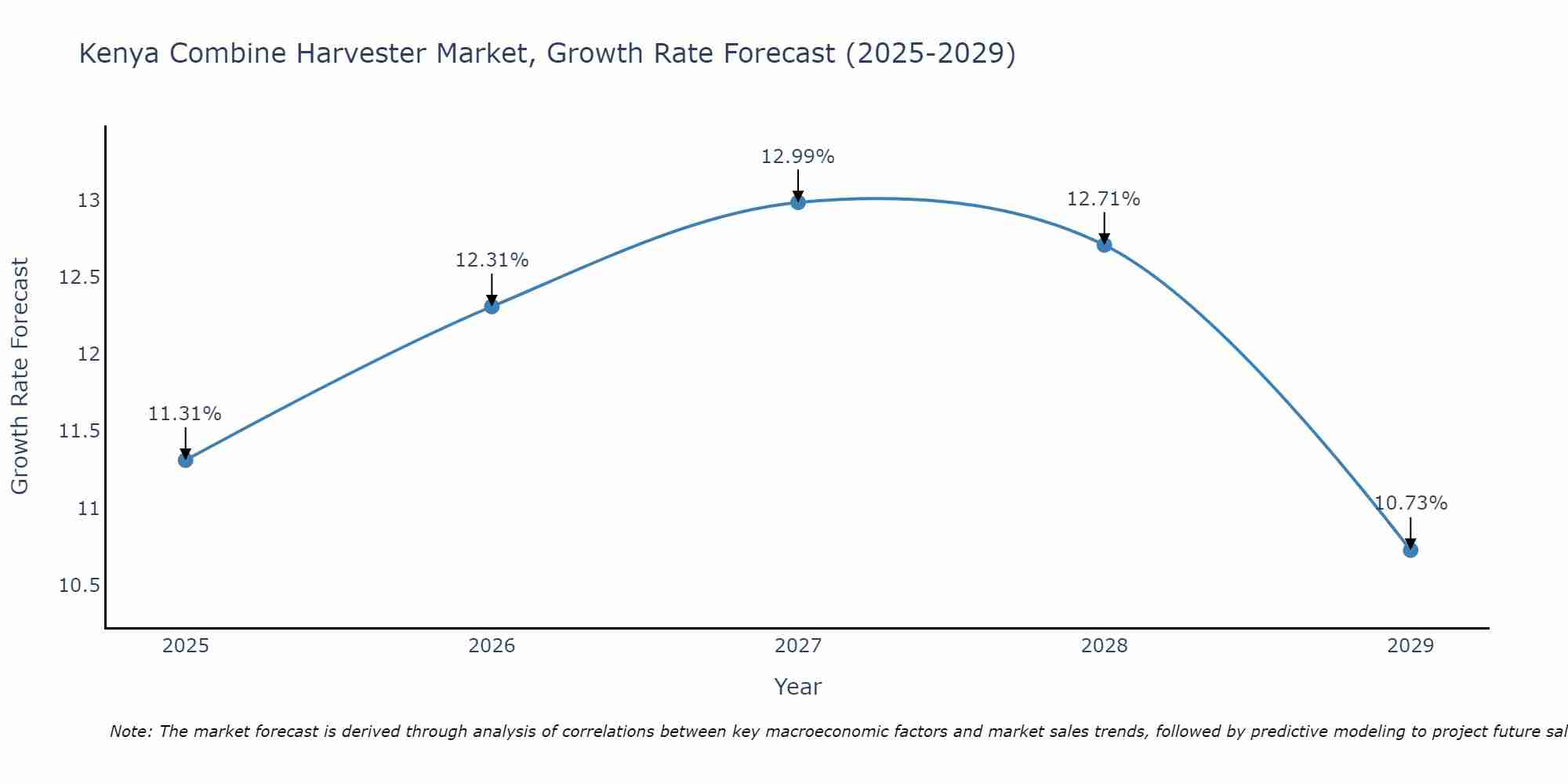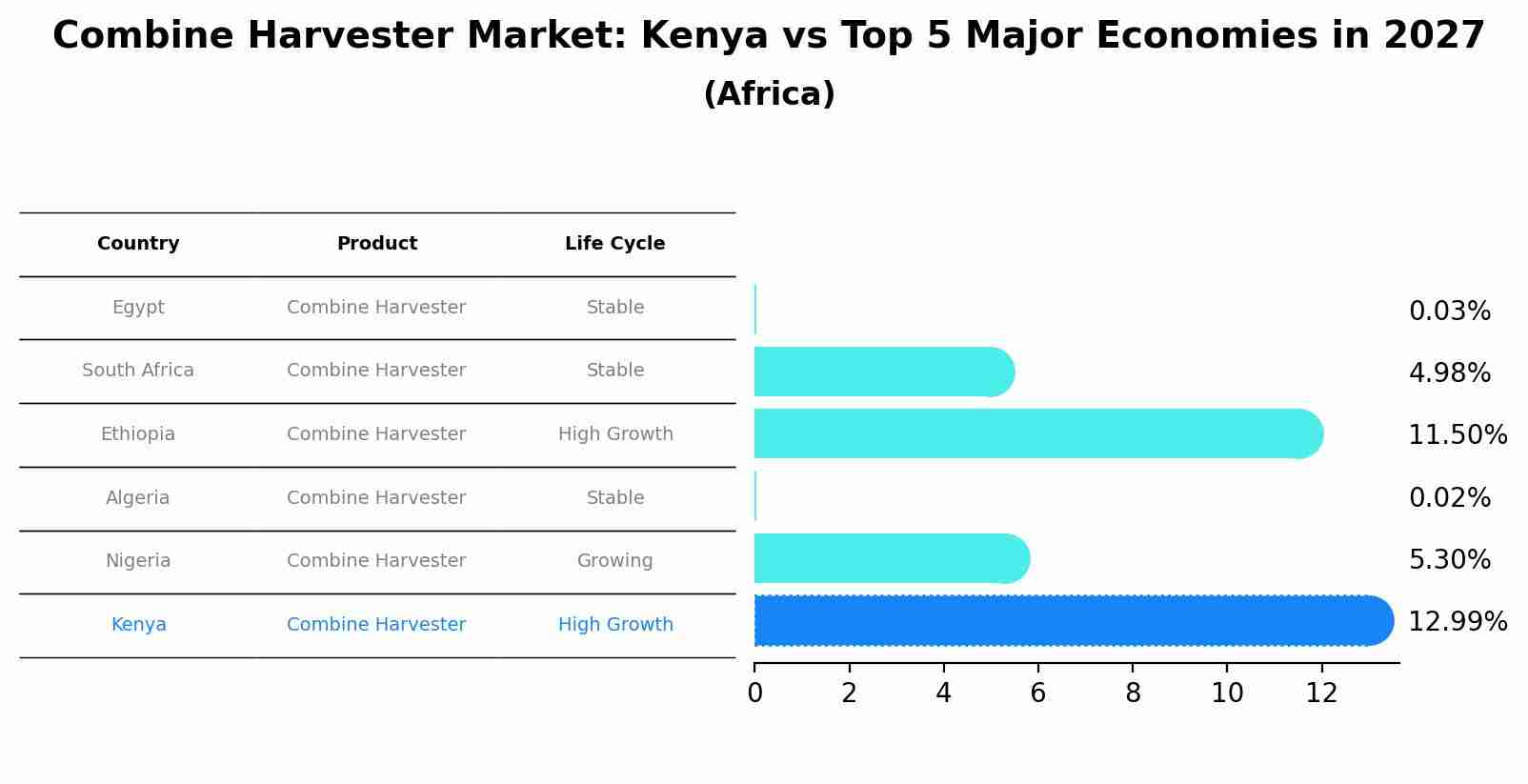Kenya Combine Harvester Market Outlook | Value, Forecast, Growth, Size, COVID-19 IMPACT, Companies, Industry, Share, Revenue, Analysis & Trends
| Product Code: ETC428746 | Publication Date: Oct 2022 | Updated Date: Aug 2025 | Product Type: Market Research Report | |
| Publisher: 6Wresearch | Author: Ravi Bhandari | No. of Pages: 75 | No. of Figures: 35 | No. of Tables: 20 |
Kenya Combine Harvester Market Size Growth Rate
The Kenya Combine Harvester Market is projected to witness mixed growth rate patterns during 2025 to 2029. Growth accelerates to 12.99% in 2027, following an initial rate of 11.31%, before easing to 10.73% at the end of the period.

Combine Harvester Market: Kenya vs Top 5 Major Economies in 2027 (Africa)
By 2027, Kenya's Combine Harvester market is forecasted to achieve a high growth rate of 12.99%, with Egypt leading the Africa region, followed by South Africa, Ethiopia, Algeria and Nigeria.

Kenya Combine Harvester Market Overview
The Kenya Combine Harvester Market provides agricultural machinery for mechanized harvesting of crops such as wheat, rice, maize, and soybeans. Combine harvesters integrate harvesting, threshing, and winnowing functions, reducing labor requirements and increasing efficiency in crop production. In Kenya, where agriculture is a significant contributor to the economy, the adoption of combine harvesters is increasing among large-scale farms and agribusinesses seeking to improve productivity and reduce post-harvest losses.
Drivers of the market
In Kenya, the Combine Harvester market is predominantly influenced by the country`s agricultural landscape and the increasing adoption of mechanized farming practices. As Kenya strives to enhance agricultural productivity and food security, there is a growing shift towards mechanization to streamline harvesting processes and improve efficiency. Combine harvesters play a pivotal role in this transition by offering capabilities for harvesting multiple crops in a single operation, thereby reducing labor costs and increasing harvesting speed. Moreover, government initiatives aimed at promoting mechanized farming and enhancing agricultural output are driving the demand for combine harvesters in the country.
Challenges of the market
Infrastructure limitations, including inadequate rural road networks, pose challenges to Kenya combine harvester market. Affordability barriers for smallholder farmers and competition from traditional farming methods also impact market dynamics.
Government Policy of the market
The Kenya government may implement policies to support mechanization in agriculture, including initiatives to promote the adoption of combine harvesters. These policies may include subsidies, financing programs, and technical assistance to encourage farmers to invest in modern harvesting equipment, improve productivity, and reduce post-harvest losses.
Key Highlights of the Report:
- Kenya Combine Harvester Market Outlook
- Market Size of Kenya Combine Harvester Market, 2021
- Forecast of Kenya Combine Harvester Market, 2028
- Historical Data and Forecast of Kenya Combine Harvester Revenues & Volume for the Period 2018 - 2028
- Kenya Combine Harvester Market Trend Evolution
- Kenya Combine Harvester Market Drivers and Challenges
- Kenya Combine Harvester Price Trends
- Kenya Combine Harvester Porter's Five Forces
- Kenya Combine Harvester Industry Life Cycle
- Historical Data and Forecast of Kenya Combine Harvester Market Revenues & Volume By Cutting Width for the Period 2018 - 2028
- Historical Data and Forecast of Kenya Combine Harvester Market Revenues & Volume By Small Size Combine Harvester for the Period 2018 - 2028
- Historical Data and Forecast of Kenya Combine Harvester Market Revenues & Volume By Large Size Combine Harvester for the Period 2018 - 2028
- Historical Data and Forecast of Kenya Combine Harvester Market Revenues & Volume By Type for the Period 2018 - 2028
- Historical Data and Forecast of Kenya Combine Harvester Market Revenues & Volume By Wheel Type Combine Harvester for the Period 2018 - 2028
- Historical Data and Forecast of Kenya Combine Harvester Market Revenues & Volume By Crawler Type Combine Harvester for the Period 2018 - 2028
- Historical Data and Forecast of Kenya Combine Harvester Market Revenues & Volume By Power Source for the Period 2018 - 2028
- Historical Data and Forecast of Kenya Combine Harvester Market Revenues & Volume By Tractor Pulled/PTO Powered Combine Harvester for the Period 2018 - 2028
- Historical Data and Forecast of Kenya Combine Harvester Market Revenues & Volume By Self-Propelled Combine Harvester for the Period 2018 - 2028
- Kenya Combine Harvester Import Export Trade Statistics
- Market Opportunity Assessment By Cutting Width
- Market Opportunity Assessment By Type
- Market Opportunity Assessment By Power Source
- Kenya Combine Harvester Top Companies Market Share
- Kenya Combine Harvester Competitive Benchmarking By Technical and Operational Parameters
- Kenya Combine Harvester Company Profiles
- Kenya Combine Harvester Key Strategic Recommendations
Frequently Asked Questions About the Market Study (FAQs):
1 Executive Summary |
2 Introduction |
2.1 Key Highlights of the Report |
2.2 Report Description |
2.3 Market Scope & Segmentation |
2.4 Research Methodology |
2.5 Assumptions |
3 Kenya Combine Harvester Market Overview |
3.1 Kenya Country Macro Economic Indicators |
3.2 Kenya Combine Harvester Market Revenues & Volume, 2021 & 2028F |
3.3 Kenya Combine Harvester Market - Industry Life Cycle |
3.4 Kenya Combine Harvester Market - Porter's Five Forces |
3.5 Kenya Combine Harvester Market Revenues & Volume Share, By Cutting Width, 2021 & 2028F |
3.6 Kenya Combine Harvester Market Revenues & Volume Share, By Type, 2021 & 2028F |
3.7 Kenya Combine Harvester Market Revenues & Volume Share, By Power Source, 2021 & 2028F |
4 Kenya Combine Harvester Market Dynamics |
4.1 Impact Analysis |
4.2 Market Drivers |
4.2.1 Government support and subsidies for mechanization in agriculture |
4.2.2 Increasing demand for efficient farming practices to improve productivity |
4.2.3 Growing adoption of advanced farming technologies in Kenya |
4.3 Market Restraints |
4.3.1 High initial cost and maintenance expenses of combine harvesters |
4.3.2 Limited awareness and technical knowledge among small-scale farmers in Kenya |
5 Kenya Combine Harvester Market Trends |
6 Kenya Combine Harvester Market, By Types |
6.1 Kenya Combine Harvester Market, By Cutting Width |
6.1.1 Overview and Analysis |
6.1.2 Kenya Combine Harvester Market Revenues & Volume, By Cutting Width, 2018 - 2028F |
6.1.3 Kenya Combine Harvester Market Revenues & Volume, By Small Size Combine Harvester, 2018 - 2028F |
6.1.4 Kenya Combine Harvester Market Revenues & Volume, By Large Size Combine Harvester, 2018 - 2028F |
6.2 Kenya Combine Harvester Market, By Type |
6.2.1 Overview and Analysis |
6.2.2 Kenya Combine Harvester Market Revenues & Volume, By Wheel Type Combine Harvester, 2018 - 2028F |
6.2.3 Kenya Combine Harvester Market Revenues & Volume, By Crawler Type Combine Harvester, 2018 - 2028F |
6.3 Kenya Combine Harvester Market, By Power Source |
6.3.1 Overview and Analysis |
6.3.2 Kenya Combine Harvester Market Revenues & Volume, By Tractor Pulled/PTO Powered Combine Harvester, 2018 - 2028F |
6.3.3 Kenya Combine Harvester Market Revenues & Volume, By Self-Propelled Combine Harvester, 2018 - 2028F |
7 Kenya Combine Harvester Market Import-Export Trade Statistics |
7.1 Kenya Combine Harvester Market Export to Major Countries |
7.2 Kenya Combine Harvester Market Imports from Major Countries |
8 Kenya Combine Harvester Market Key Performance Indicators |
8.1 Average farm size in Kenya |
8.2 Number of agricultural training programs focusing on mechanization |
8.3 Adoption rate of combine harvesters in different regions of Kenya |
8.4 Efficiency improvement in crop harvesting techniques |
8.5 Average yield per hectare of crops harvested using combine harvesters |
9 Kenya Combine Harvester Market - Opportunity Assessment |
9.1 Kenya Combine Harvester Market Opportunity Assessment, By Cutting Width, 2021 & 2028F |
9.2 Kenya Combine Harvester Market Opportunity Assessment, By Type, 2021 & 2028F |
9.3 Kenya Combine Harvester Market Opportunity Assessment, By Power Source, 2021 & 2028F |
10 Kenya Combine Harvester Market - Competitive Landscape |
10.1 Kenya Combine Harvester Market Revenue Share, By Companies, 2021 |
10.2 Kenya Combine Harvester Market Competitive Benchmarking, By Operating and Technical Parameters |
11 Company Profiles |
12 Recommendations |
13 Disclaimer |
- Single User License$ 1,995
- Department License$ 2,400
- Site License$ 3,120
- Global License$ 3,795
Search
Thought Leadership and Analyst Meet
Our Clients
Related Reports
- Germany Breakfast Food Market (2026-2032) | Industry, Share, Growth, Size, Companies, Value, Analysis, Revenue, Trends, Forecast & Outlook
- Australia Briquette Market (2025-2031) | Growth, Size, Revenue, Forecast, Analysis, Trends, Value, Share, Industry & Companies
- Vietnam System Integrator Market (2025-2031) | Size, Companies, Analysis, Industry, Value, Forecast, Growth, Trends, Revenue & Share
- ASEAN and Thailand Brain Health Supplements Market (2025-2031) | Strategy, Consumer Insights, Analysis, Investment Trends, Opportunities, Growth, Size, Share, Industry, Revenue, Segments, Value, Segmentation, Supply, Forecast, Restraints, Outlook, Competition, Drivers, Trends, Demand, Pricing Analysis, Competitive, Strategic Insights, Companies, Challenges
- ASEAN Bearings Market (2025-2031) | Strategy, Consumer Insights, Analysis, Investment Trends, Opportunities, Growth, Size, Share, Industry, Revenue, Segments, Value, Segmentation, Supply, Forecast, Restraints, Outlook, Competition, Drivers, Trends, Demand, Pricing Analysis, Competitive, Strategic Insights, Companies, Challenges
- Europe Flooring Market (2025-2031) | Outlook, Share, Industry, Trends, Forecast, Companies, Revenue, Size, Analysis, Growth & Value
- Saudi Arabia Manlift Market (2025-2031) | Outlook, Size, Growth, Trends, Companies, Industry, Revenue, Value, Share, Forecast & Analysis
- Uganda Excavator, Crane, and Wheel Loaders Market (2025-2031) | Strategy, Consumer Insights, Analysis, Investment Trends, Opportunities, Growth, Size, Share, Industry, Revenue, Segments, Value, Segmentation, Supply, Forecast, Restraints, Outlook, Competition, Drivers, Trends, Demand, Pricing Analysis, Competitive, Strategic Insights, Companies, Challenges
- Rwanda Excavator, Crane, and Wheel Loaders Market (2025-2031) | Strategy, Consumer Insights, Analysis, Investment Trends, Opportunities, Growth, Size, Share, Industry, Revenue, Segments, Value, Segmentation, Supply, Forecast, Restraints, Outlook, Competition, Drivers, Trends, Demand, Pricing Analysis, Competitive, Strategic Insights, Companies, Challenges
- Kenya Excavator, Crane, and Wheel Loaders Market (2025-2031) | Strategy, Consumer Insights, Analysis, Investment Trends, Opportunities, Growth, Size, Share, Industry, Revenue, Segments, Value, Segmentation, Supply, Forecast, Restraints, Outlook, Competition, Drivers, Trends, Demand, Pricing Analysis, Competitive, Strategic Insights, Companies, Challenges
Industry Events and Analyst Meet
Whitepaper
- Middle East & Africa Commercial Security Market Click here to view more.
- Middle East & Africa Fire Safety Systems & Equipment Market Click here to view more.
- GCC Drone Market Click here to view more.
- Middle East Lighting Fixture Market Click here to view more.
- GCC Physical & Perimeter Security Market Click here to view more.
6WResearch In News
- Doha a strategic location for EV manufacturing hub: IPA Qatar
- Demand for luxury TVs surging in the GCC, says Samsung
- Empowering Growth: The Thriving Journey of Bangladesh’s Cable Industry
- Demand for luxury TVs surging in the GCC, says Samsung
- Video call with a traditional healer? Once unthinkable, it’s now common in South Africa
- Intelligent Buildings To Smooth GCC’s Path To Net Zero


















